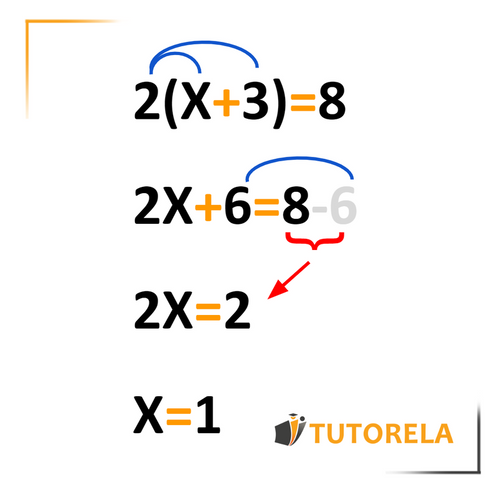Solving an equation using the distributive property is related to the need to open the parentheses as the first step to then be able to simplify similar members. When an equation contains one or more pairs of parentheses, we must start by opening them all and then proceed to the next phase.
Solving Equations Using the Distributive Property
Below, we provide you with some examples where this method is applied.
In this equation, we can clearly see some parentheses. To start, we must open them (that is, apply the distributive property) and then we can proceed with the following phases of the exercise.
The result of the equation is .

Test yourself on solving quadratic equations using factoring!
\( 3x+5(x+4)=0 \)
Another example
In this equation, we clearly see that there are two pairs of parentheses, one on each side. To begin, we must open them (that is, apply the distributive property) and then we can proceed with the following phases of the exercise.
The result of the equation is .
If this article interested you, you might also be interested in the following articles
- First-degree equations with one unknown
- What is the unknown of a mathematical equation?
- Equivalent equations
- Transposition of terms
- Solving equations by adding or subtracting the same number from both sides
- Solving equations by multiplying or dividing both sides by the same number
- Solving equations by simplifying like terms
- Solution of an equation
- Exponential equations
On the Tutorela website, you will find a wide variety of articles about mathematics
Examples and exercises with solutions for solving equations using the distributive property
Exercise #1
Determine the value of :
Video Solution
Step-by-Step Solution
Let's first expand the parentheses using the formula:
Next, we will substitute in our terms accordingly:
Then, we will move the 16 to the left-hand side, keeping the appropriate sign:
Finally, we divide both sides by 2:
Answer
Exercise #2
Video Solution
Step-by-Step Solution
Let's proceed to solve the linear equation :
Step 1: Distribute the 3 in the expression .
We get:
This simplifies to:
Step 2: Simplify the expression by combining like terms.
We simplify this to:
or simply
Step 3: Isolate by dividing both sides by 3.
Thus,
Therefore, the solution to the problem is .
The correct choice is the option corresponding to .
Answer
Exercise #3
Solve for y:
Video Solution
Step-by-Step Solution
To solve the equation , we will follow these steps:
- Step 1: Distribute inside the parenthesis.
- Step 2: Simplify and combine like terms.
- Step 3: Solve the equation for .
Let's proceed with the solution:
Step 1: Distribute in the expression . This will transform the expression as follows:
.
After distributing, the equation becomes:
.
Step 2: Combine like terms. Notice that is equivalent to :
.
Step 3: Solve for . First, isolate the term with by subtracting 8 from both sides:
.
Next, divide both sides by to find :
.
Thus, the solution for is , which can be written as a mixed number:
.
Therefore, the solution to the problem is .
Answer
Exercise #4
Video Solution
Step-by-Step Solution
To solve the given linear equation , follow these steps:
- Step 1: Simplify the equation.
Start by distributing the negative sign through the parentheses:
- Step 2: Combine like terms.
Combine the constant terms on the left side:
- Step 3: Isolate the variable .
Subtract 6 from both sides of the equation to isolate the term with :
- Step 4: Solve for .
Divide both sides by -3 to solve for :
Therefore, the solution to the equation is .
Answer
Exercise #5
Video Solution
Step-by-Step Solution
To solve the linear equation , we'll proceed with the following steps:
Step 1: Apply the Distributive Property.
The equation given is .
First, distribute the 2 across the terms inside the parenthesis:
.
By substituting this back into the equation, we have:
.
Step 2: Combine Like Terms.
Now, combine the terms containing :
.
The equation now becomes:
.
Step 3: Isolate the Variable.
Add 14 to both sides of the equation to isolate terms with :
, which simplifies to:
.
Next, divide both sides by 14 to solve for :
.
Therefore, the solution to the equation is .
Answer
\( 8a+2(3a-7)=0 \)
\( 3(a+1)-3=0 \)
\( 5-(3b-1)=0 \)
More Questions
Solving Quadratic Equations using Factoring
- Equivalent Equations
- Solving Equations by Adding or Subtracting the Same Number from Both Sides
- Solving Equations by Multiplying or Dividing Both Sides by the Same Number
- Solving Equations by Simplifying Like Terms
- Functions for Seventh Grade
- Increasing and Decreasing Intervals (Functions)
- Increasing functions
- Decreasing function
- Constant Function
- Decreasing Interval of a function
- Increasing Intervals of a function
- Domain of a Function
- Indefinite integral
- Inputing Values into a Function
- Rate of Change of a Function
- Variation of a Function
- Rate of change represented with steps in the graph of the function
- Rate of change of a function represented graphically
- Constant Rate of Change
- Variable Rate of Change
- Rate of Change of a Function Represented by a Table of Values
- Ways to Represent a Function
- Representing a Function Verbally and with Tables
- Graphical Representation of a Function
- Algebraic Representation of a Function
- Notation of a Function
- Solution by all methods









